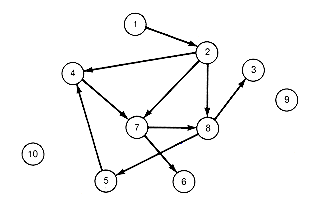
One can represent any binary relation R on a set of n objects graphically, as in Figure 11.1. Let S consist of ten objects, the integers 1, 2, 3, . . . , 10. Take R to contain the pairs (1, 2), (8, 3), (7, 6), (2, 7), (5, 4), (7, 8), (2, 4), (4, 7), (2, 8), (8, 5). Create a node for each object in S and draw arrows between two nodes for each pair in R. For example, an arrow will appear from 7 to 8 for the pair (7, 8).
Any such diagram can be interpreted as representing a binary relation on a set S. For such a diagram to represent a partial order requires that
n No arrows appear from any node to itself (irreflexivity)
n No arrows appear from any node i to another node j and back from j to i (asymmetry)
n If arrows appear from i to j and from j to k, then an arrow must appear from i to k (transitivity)
In depicting partial orders, it is unnecessary to draw all the arrows needed to represent transitivity, because they are always assumed. With this understanding, it is not difficult to see that a diagram represents a partial order if and only if it contains no loops. This means that no node can be found such that one can follow a series of arrows starting from that node and ending at that node. In Figure 11.1, there is a loop involving nodes 5, 4, 7, and 8. Hence the diagram does not represent a partial order. Note that if one starts with a diagram representing a partial order (no loops), erasing a node and all arrows emanating from it results in a diagram that represents a new partial order on the set of remaining nodes.
